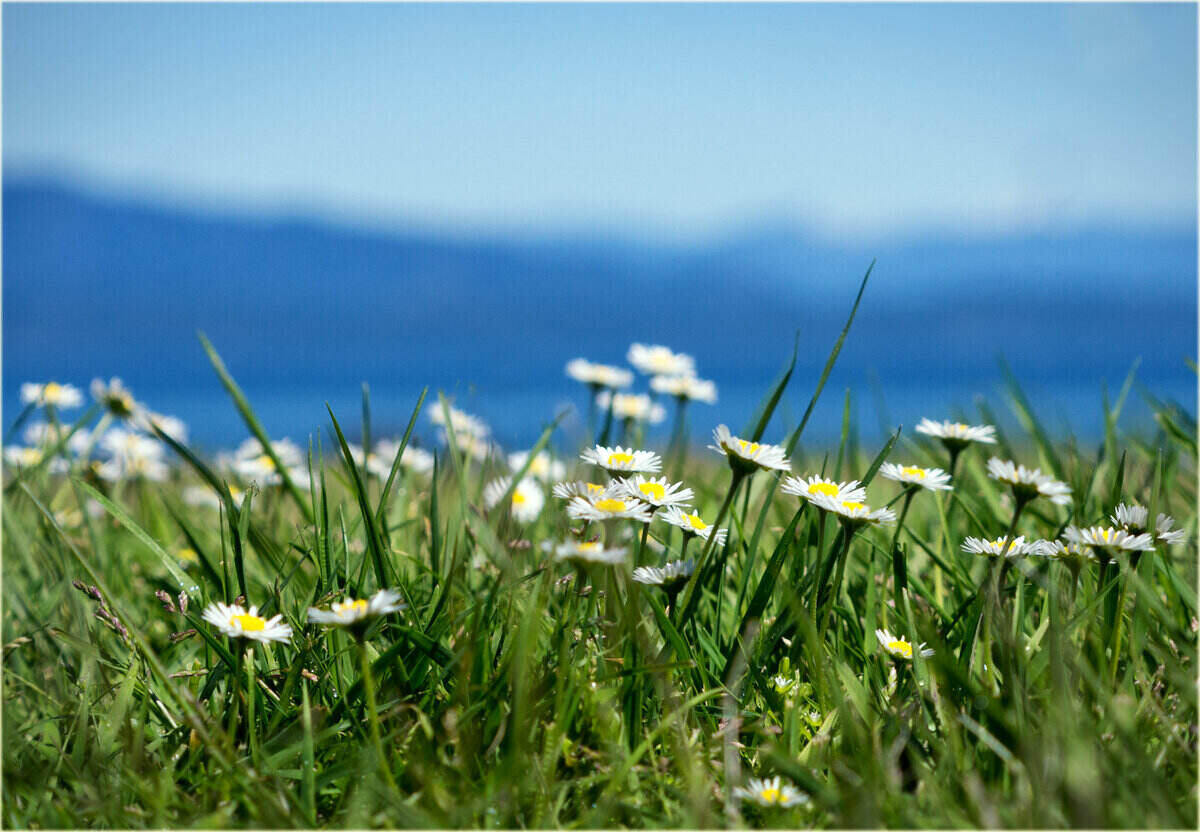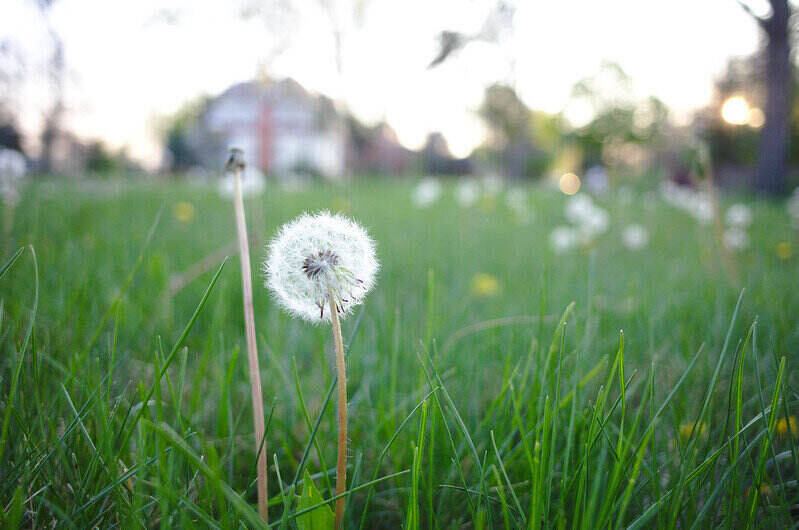
As the weather warms up, you’ll want to be spending your free time exploring the Frederik Meijer Gardens, checking out exhibits at the Festival of the Arts, or tasting some brews in Beer City. Spending time doing yard work is probably not at the top of your list. If you get ahead of your spring lawn care, you will have more time for the things you enjoy and have a beautiful yard for months to come.
You can have a grand backyard in Grand Rapids if you follow these seven spring lawn care tips:
- Get ahead of diseases
- Repair and prepare your equipment
- Clean up your lawn
- Analyze your soil
- Wait to aerate and overseed
- Watch out for weeds
- Dethatch if needed
1. Get ahead of diseases

Diseases that plague your lawn are usually preventable. They are often caused by wet and humid weather, an imbalance in soil nutrients, and overgrown grass. When looking for areas of affected grass, look for missing grass and brown patches and grass that is matted down and appears to have a white or gray fungus growth.
How to minimize lawn disease:
- Avoid excessive levels of nitrogen or other nutrients
- Plant disease-resistant grass
- Limit watering to the early morning hours
The four most common kinds of lawn disease in Western Michigan are red thread, necrotic ring spot, dollar spot, and snow mold.
Red thread
What to look for:
- Irregular-sized bleached patches of grass
- Water-soaked areas of grass
- Red-pink fungus
How to treat red thread:
- Red thread primarily affects bluegrasses, fescues, and ryegrasses that have a nitrogen deficiency. It occurs during the spring and fall during humid and warm weather. Red thread can easily be taken care of with fungicides, but making sure your lawn is healthy is a more effective long-term strategy. Try adding fertilizer first before relying on fungicides.
Necrotic ring spot
What to look for:
- Sunken areas of the lawn
- Black fungus
- Rings of red or straw-colored grass
How to treat necrotic ring spot:
- Necrotic ring spot is difficult to treat, so take action right away if you spot signs of it in your yard. Fungicides can be effective so long as the disease hasn’t already severely damaged your grass. It occurs between April and October in bluegrasses and fescues.
Dollar spot
What to look for:
- Silver dollar-sized spots of dead grass
- White growth on top of the grass in the mornings
How to treat dollar spot:
- Dollar spot occurs during spring, summer, and fall. This fungal disease has multiple strains, some of which are resistant to fungicide. Try alternating between different fungicides to treat affected areas.
Snow mold
What to look for:
- Bleached, circular patches up to two feet wide; can have a pinkish tint
- Matted grass surrounded by white-gray fungal growth
How to treat snow mold:
- Snow mold occurs with melting snow or during cold, wet weather. The most effective form of treatment is to apply fungicide to the affected area and rake the mold away. Active ingredients that work with both gray and pink snow mold include azoxystrobin, bacillus subtilis, and propiconazole.
2. Repair and prepare your equipment

It’s time to take the lawn equipment out of hibernation and check that they are clean and ready to be used before the grass starts getting too high. Blades on your equipment will dull over time and frequent use, and working with dull blades can damage your grass.
Why you shouldn’t mow with a dull blade
- Bruises your grass
- Makes the grass more vulnerable to disease
- Can tear and damage the grass leaves
- Causes your lawn to look dull and brown
Not sure how worn your blades are? Take a close look at your grass after it’s cut. If the grass is uneven and torn, it’s time for new or resharpened blades. If you need your blades sharpened, you can do it yourself or you can bring it to a professional at your local lawn equipment and repair shop.
Do it yourself – how to sharpen the blade on your lawn mower:
- Disconnect the spark plug.
- Use a wrench to remove the bolt from the blade.
- Take off the blade.
- Use a paint scraper to clean the blade.
- Secure the blade and sharpen the edge using a file.
- Hang the blade on a nail to make sure it is relatively level. If one side leans too much to one side, take off more metal to make the blade hang level.
- Use an air compressor or paint scraper to remove built-up debris from underneath the deck.
- Put the blade back on the mower.
- Reconnect the spark plug.
Pro Tip: Change your mower’s oil every 20 to 50 hours of use.
Do you have other equipment to take care of such as hedge trimmers, weed eaters, and leaf blowers? Use this checklist to make sure these are ready to go:
- Check to see if your gas-powered tools need more gas
- Check to see if your battery-powered tools need to be charged
- Change the engine oil, replace the filter, and replace the spark plug on your gas-powered lawn mower
- Load new line into your weed eater
Taking care of these tasks ahead of time will ensure your equipment is ready when your lawn is ready for the first mow of the season.
3. Clean up your lawn

Harsh winter weather can lead to broken branches and other debris piling up on your lawn. Leaving dead leaves, plants, and broken branches in your yard can lead to several issues:
- Blocks light from reaching the lawn, preventing growth and photosynthesis
- Prevents nutrients and water from being absorbed by the grass’s roots
- Invites diseases
- Provides shelter to invasive pests
Once your lawn is clear of debris, you can more easily take care of your lawn to help it grow lush and healthy.
4. Analyze your soil

Winter conditions can have a big impact on your soil’s health, which is why it’s important to get your soil tested. If you want a healthy lawn, a soil test will tell you what’s missing and help you make amendments to balance nutrients in your soil. Your soil might be too acidic or too alkaline, or maybe it’s lacking in potassium, calcium, or lime.
What influences soil acidity?
- Rain: Rain absorbs acids in the atmosphere, which it carries back down to the earth. These acids seep into the ground and tend to have a higher concentration in metropolitan areas. Grand Rapids tends to receive around 37 inches of rainfall annually, which can leach nutrients from the topsoil, and increase overall levels of soil acidity.
- Fertilizer: Depending on the fertilizer you use, it can increase or decrease soil pH levels. Fertilizers with ammonium will lower your soil’s pH level, and lead to increased acidity as it converts to nitrate after being added to the soil.
- Microbes: Microbes lead to increased levels of acidity as they decompose organic matter.
How to test your soil:
There are two testing options: a DIY kit you can use at home, or you can send a sample of your soil to a local testing lab.
- Soil test kits are simple and inexpensive. They will usually let you know what your soil’s pH level is and what nutritional deficiencies it may be experiencing.
- A full soil analysis will give you more information about the health of your soil. You can reach out to the Kent County Extension office to learn about their soil testing options.
Once you get the results back, be sure to add amendments to the soil at least a month before you plan on adding fertilizer. Waiting will ensure there are no negative reactions between the fertilizer and the amendments you’ve made.
5. Wait to aerate and overseed

Aeration and overseeding are both highly beneficial to the health and appearance of your lawn, but these tasks are best saved for the fall.
Why wait until fall?
Your cool-season grass grows best in the fall when the soil is not too cold or too hot. Removing any thatch that has accumulated over the year by aerating before overseeding will help the new grass grow thick and healthy. You will have a lush fall lawn that, if maintained, will have a better chance of surviving the winter and growing strong in the spring.
6. Watch out for weeds

Springtime brings birds, bees, and unfortunately, weeds. The warmer temperatures, along with melting snow and spring rain, create an environment where weeds can thrive. However, you can get ahead of the weeds if you are prepared.
A pre-emergent herbicide should be applied in the spring when the soil temperatures begin to consistently reach 50-55 degrees. This will get ahead of weeds such as crabgrass, protecting the beauty of your lawn before they get the chance to spread.
Spring weeds to watch out for:
- Crabgrass
- Dandelion
- Thistle
- Bindweed
- Nutsedge
Wait until the summer to apply a post-emergent herbicide. This will get rid of any weeds that made it through the spring.
7. Dethatch if needed

For cool-season grasses, the ideal time to dethatch is in the fall when the grass is growing. However, if it’s time for your yard to be dethatched, it’s not a bad idea to do it while the soil is moist from spring rain or melted snow.
What is thatch?
Thatch is a layer of dead grass that is tightly interwoven with living grass. Thatch occurs when grass grows rapidly, to the extent that there isn’t enough time for dead grass to decompose.
In small amounts, thatch can be beneficial — it can make your lawn more springy and resilient. However, it needs to be taken care of once it is more than a ½ inch thick. Signs that you might need to dethatch include dry spots, decreased grass resilience, and increased pests and disease.
Why dethatch?
- It holds onto moisture leading to increased disease and fungal growth
- It prevents nutrients and water from being absorbed into the soil
- It hosts pests and insects that cause further damage and disease
- It prevents proper root growth
There are two primary methods of dethatching:
- Rake method: Use the tines of the rake to dig into the thatch, then pull the rake up, pulling thatch out of the ground.
- Dethatcher method: Carefully follow the instructions of your rental dethatcher. Be sure that the blades cut no more than a half-inch into the soil.
When you’re done dethatching, be sure to rake away the debris, fill in any new bare patches, and fertilize your lawn.
Pro Tip: Make sure your grass isn’t too wet when you’re dethatching. If the soil is wet and loose, you’ll end up making a big mess. If you squeeze the soil with your hand and it’s mushy and mud-like, wait until it dries a bit more before dethatching.
You can grow a grand lawn in Grand Rapids
By taking care of your lawn in the spring, you’re giving it a head start for the rest of the year. All it takes is a little time and effort at the beginning of the season, and you can sit back and watch the fruits of your labor as you enjoy your lawn through spring and summer.
Don’t have the time to do yard chores yourself? There are plenty of local lawn care experts who are ready and happy to help. Reach out to a Grand Rapids lawn care pro to check off your to-do list for you.
Main Photo Credit: marneejill | Flickr | CC BY-SA 2.0